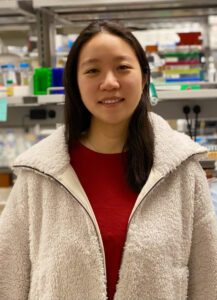Nanotechnology at Northwestern
Meet Zhaoyi Gu, a graduate student in the Mrksich Group
April 08, 2022
Zhaoyi Gu is a graduate student in the Mrksich Group, which uses the tools of organic chemistry, materials science, and biochemistry to address important challenges in and at the intersection of chemistry and biology.

Where are you originally from?
I’m from Shanghai, China.
Where did you complete your undergraduate degree?
I completed my undergraduate degree in chemical biology at UC Berkeley in California.
When did you first become interested in biomaterials?
As a chemical biology major, many things I learned were focused on fundamental knowledge in chemistry and biology. During my junior year, I took two bioengineering electives taught by Prof. Seung-Wuk Lee. From the two classes, I was intrigued by how biological building blocks can be carefully designed and assembled into novel materials that never existed in nature, and I became particularly interested in self-assembly and biomaterials.
How do you explain what you study to non-scientists?
Our group has a platform called megamolecules that allows the modular assembly of proteins and small organic molecules. Using this platform, we can create diverse structures for applications in biomedicine and materials science. My current work focuses on using megamolecules as building blocks to create dynamic protein-based assemblies, including filaments and lattices.
What are the challenges you’re trying to solve with megamolecules? And what kind of potential do you see for them?
Proteins are one of the most versatile building blocks in nature, but their assemblies can be challenging due to their inherent flexibility and heterogeneity. To create well-defined supramolecular structures instead of amorphous structures that are arranged randomly, the megamolecule building blocks and the linking groups need to be carefully tailored.
The megamolecule-based network will provide a fundamental platform for engineering new functional materials for applications in biomedicine, catalysis, and sensing. Although numerous protein-based assemblies have been created, it can be difficult to generate functional materials based on those platforms. Many previous designs are based on pre-existing symmetry or sophisticated associative patches. While well-defined and discrete materials can be created through these approaches, the incorporation of extra functional domains can disrupt such geometric restriction and associative interfaces.
Our assembling strategies bypass the need to design complex noncovalent interfaces. Furthermore, the modularity of megamolecules allows us to artificially impose symmetry. Therefore, the addition of functional domains should not disrupt the final assembled architecture and thus offers huge potential for a broad range of applications with our megamolecule assemblies.
What has been a highlight of your time at Northwestern?
A highlight was when I successfully synthesized a molecule that I had been working on for months. It can be frustrating when you go to the lab every day, work hard for long hours, and still have nothing that works. However, I felt everything paid off when I got the results I wanted, and it was one of the best moments I experienced at Northwestern.
What has been the most challenging aspect of your work or your time at Northwestern?
Starting graduate school during the pandemic was difficult. Thankfully, my cohorts and group members helped me make a quick transition and adjust to graduate school life.
Can you tell me about your experiences either being mentored or mentoring others?
I felt very lucky that I had my mentor’s guidance and support when I joined the lab. With only some experience in polymer synthesis and molecular biology, I had to learn everything from the beginning. From organic synthesis to cloning and protein chemistry, my mentor is always willing to share advice and helped me develop crucial skills in conducting my research.
What are your hobbies outside of the lab?
Outside of the lab, I love to play anime/game music on the piano, try new restaurants, and play video games.